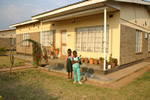 |
| DuraBric has been used in Malawi since 2013, initial projects including stock housing units can be built in 15 to 25 days at 20 to 40 percent less cost than conventional methods. LafargeHolcim and CDC envision an entity that will extend production of the earth-cement brick in Malawi and other developing nations. |
LafargeHolcim Ltd. and U.K. development finance institution CDC Group Plc have teamed to establish a company aimed at scaling up production of DuraBric, a simple, reliable and environmentally-friendly building solution the Swiss cement, concrete and aggregate giant launched in Malawi three years ago.
LafargeHolcim officials track a majority of the African nation’s greenhouse gas emissions to deforestation and forest degradation, closely linked to another emissions source: Wood-fired clamp kiln production of burnt bricks, the main building material in Malawi. As an alternative to burnt units, DuraBric comprises a mixture of earth with 5 to 8 percent cement factor, and cures naturally in the sun after demolding.
“DuraBric offers many benefits compared to the traditional bricks used in the developing world: It is easy to manufacture, has a smaller environmental footprint, offers more resistance, and all at a lower cost,” explains LafargeHolcim Executive Committee Member Gérard Kuperfarb, who oversees Growth and Innovation. “Through the new company we are setting up with CDC, we will accelerate development of this affordable, low-carbon solution.”
More than 3 million DuraBric have been used on upward of 500 buildings to date in Malawi. Under LafargeHolcim management, the new company will seek to extend product availability in Malawi and other developing, deforestation-prone countries. It will provide brick makers soil-testing and related on-site technical support, along with production equipment. Wholly owned by the U.K. Department for International Development, CDC will invest alongside LafargeHolcim and contribute expertise in projects with strong social and environmental dimensions.
CRH 2015 ‘DEVELOPMENT’ APPROACHES $9B
Crunching numbers on deals affecting operations in North America, Europe and Asia, Dublin-based CRH Plc closed 2015 with about $8.8 billion in acquisitions, and divestments netting proceeds near $1 billion. Anchoring the calendar was a $7.2 billion transaction for the lion’s share of cement, concrete and aggregate production assets Lafarge S.A. and Holcim Ltd. sold in conjunction with their July merger.
“Portfolio management, and in particular the reallocation of capital from lower growth areas into core businesses for growth, is a cornerstone of our value creation model,” noted CRH Chief Executive Albert Manifold in a 2015 Development Strategy Update. Targeted bolt-on investments strengthened North American and European businesses, he added, while divestments in a multi-year streamlining program reached $1.5 billion.
In North America, the company transitioned the Holcim (Canada) Inc. enterprise and limited Holcim (US) Inc. operations to CRH Canada Group, a companion to the Atlanta-based Oldcastle Inc. flagship. Oldcastle logged 14 divestments, totaling nearly $300 million, and 15 acquisitions valued at about $155 million. Oldcastle Materials disposed of four non-core operations and completed an asset exchange, nine bolt-on acquisitions, and three companion deals—the latter two adding annualized sales of $200 million and 250 million-plus tons of aggregate reserves.
Oldcastle Products sold six operations across the United States, including Merchant Metals, a fencing system and perimeter control product distributor, plus all of its businesses in Argentina and Chile. Three transactions in 2015 added annualized sales of $55 million. Outside of Products and Materials businesses, the Oldcastle Envelope business saw significant expansion with the $1.3 billion acquisition of C.R. Laurence Co., a Los Angeles-based glazing hardware and installation specialist.
Aside from assimilation of former Lafarge and Holcim businesses, CRH Europe reported 15 divestments last year—led by an equity stake in an operation based in Israel, plus non-core ready mixed and manufactured-concrete production assets—and five acquisitions complementing materials and distribution businesses. Most notable among concrete production investments were the addition of a paving stone plant in Poland and launch of a joint venture tied to existing ready mixed operations in Russia.
